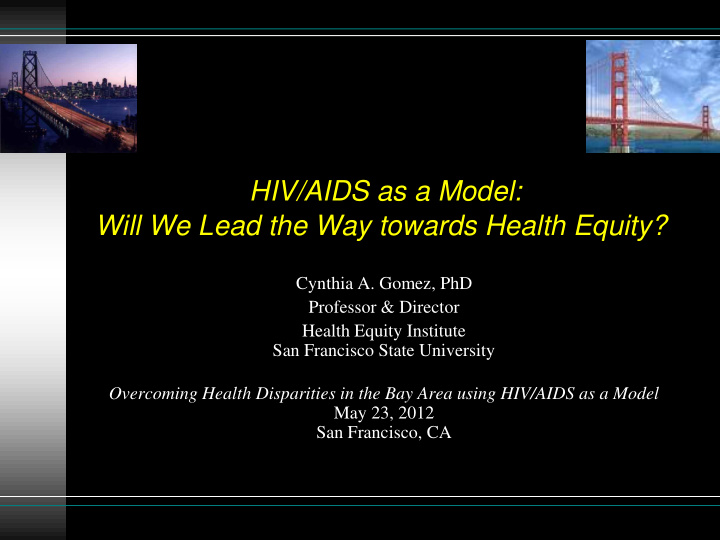



HIV/AIDS as a Model: Will We Lead the Way towards Health Equity? Cynthia A. Gomez, PhD Professor & Director Health Equity Institute San Francisco State University Overcoming Health Disparities in the Bay Area using HIV/AIDS as a Model May 23, 2012 San Francisco, CA
July 3, 1981 Rare Cancer Seen in 41 Homosexuals By LAWRENCE K. ALTMAN Doctors in New York and California have diagnosed among homosexual men 41 cases of a rare and often rapidly fatal form of cancer. Eight of the victims died less than 24 months after the diagnosis was made.
Stigma
From Beginning to End • The San Francisco Model: Community Mobilization • PLWH/A advocacy • East Bay hub for social justice: Oakland’s state of emergency highlighting disproportionate impact of AIDS on African American communities • Progressive gay and transgender politics • Biomedical/behavioral innovation
Seeking Global Health Equity The greatest wealth is health. ~ Virgil HEALTH ≠ HEALTHCARE
Real-World Contexts Health and the Millennium Development Goals: 2000 • Eradicate extreme poverty and hunger 20 05 keep the • promise Achieve universal primary education • 2015 Promote gender equality and empower women • Reduce child mortality • Improve maternal health m • Combat HIV/AIDS, malaria and other diseases d g • Ensure environmental sustainability • Develop a global partnership for development Health and the Millennium Development Goals
Health Inequities “Health inequities are differences in health status and mortality rates across population groups that are systemic, avoidable, unfair, and unjust.” Margaret Whitehead World Health Organization
Definition – Health Equity* A desirable goal/standard that entails special efforts to improve the health of those who have experienced social or economic disadvantage. Health equity is oriented toward achieving the highest level of health possible for all groups. * Healthy People 2020
HEALTHY PEOPLE The Surgeon General's Report On Health Promotion And Disease Prevention 1979 Contributors to Ten Leading Causes of Death in 1976 Behavior 10% Environment 20% 50% Human Biology 20% Inadequate healthcare
Determinants of Health Policies & Interventions Behavior Physical Social Individual Environment Environment Biological Access to Quality Healthcare David Satcher, 2003
How Are the Social and Physical Environment Defined? • The social environment is the aggregate of social, economic, and cultural institutions, norms, patterns, beliefs, and processes that influence the life of an individual or community. • The physical environment comprises the structures and functions of both the natural and built environments that influence the health of individuals or communities. • “Societal determinants” refers to both the social and the physical environmental realms.
EXAMPLES OF DIFFERENCES IN LIFE EXPECTANCY BY NEIGHBORHOOD • Bayview/Hunters Point <14 years compared with Russian Hill (City and County of San Francisco) • Bay Point <11 years compared with Orinda (Contra Costa County) • West Oakland <14 years compared with the hills (Alameda County )
Cost of Poverty in San Francisco Bay Area • Every additional $12,500 in household income buys one year of life expectancy • (Benefit appears to plateau at household incomes above $150,000) • Similar gradients in Baltimore, NYC, Philadelphia, Hennepin County (Minneapolis St. Paul), Colorado, California, AND Cuyahoga County ($6304/year of life)
EXAMPLES OF INSTITUTIONAL POWERS THAT INFLUENCE NEIGHBORHOOD CONDITIONS • “BUILT” ENVIRONMENT • LAND USE PLANNING • TRANSPORTATION • ECONOMIC DEVELOPMENT • REDEVELOPMENT • PORT • “NATURAL” ENVIRONMENT • AIR, WATER, SOIL • SOCIAL ENVIRONMENT • ECONOMIC INVESTMENT, EMPLOYMENT • CLASS, RACIAL/ETHNIC COMPOSITION • SCHOOLS
Health Health Inequities Disparities
Opportunities for Intervention • Individual • Community • Organizations • Science • Politics • Society/Policy
Individual • Health Literacy • Access to Care • Vaccine/PrEP Readiness • Early Diagnosis • Support Systems/Holistic Approaches • Treatment • Adherence
Community: Asset-Based • Healthcare Infrastructure in Community • Partnering with Local Healers • Education /Training by Local Leaders • Economic Development – Local Products • Embrace Multi-Cultural Heritage
Paradigm Shift for Health • Right to Know • To Be Counted • To Contribute • To Consult • To Deliberate • To Demand
Challenges • Weak and inequitable health systems • Individual versus structural and up- stream strategies • Self versus community focus • Inadequate public policies
What Role Do We Play? • Research • Clinical/Community Practice • Policy-Setting/Advocacy • Trans-disciplinary Approaches
Community-Engaged Research • meaningful collaboration between researchers and community leaders to help end health disparities in communities • interdependent, mutually beneficial relationship that requires regular communication and negotiation in pursuit of common goals
What Role Do We Play? • Clinical Practice • Cells and people in context • Policy-Setting • involvement • Trans-disciplinary Approach • Broader lens • Cultural experience
Working in the Trenches
Return to Activism
Social Determinants of Health & Futures
Creating Change that Matters Scientific Community Evidence Evidence
Let’s Lead the Way HealthEquityInstitute.org
Recommend
More recommend